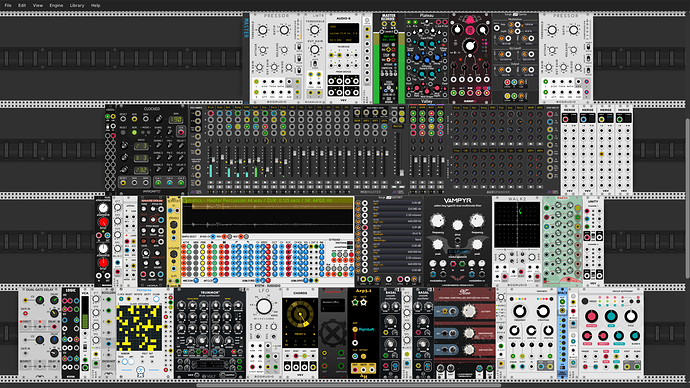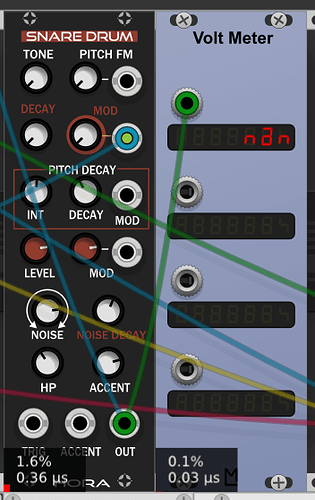No, I do not.
Ah OK - I read Resonator had an issue where it would crash and output 10v so I wondered if it was that. If a module sends out 10v DC MixMaster will past through to the main outputs. In the master track settings on MM there is a DC Blocker though that will prevent DC signals passing through to the outputs when enabled.
We have just released a new version of the MindMeld plugin that includes MixMaster Junior - an 8 track / 2 group bus version of the mixer. This release also includes +/- 20v voltage clamping on all the inputs that should hopefully protect it from misbehaving modules that output extreme voltages.
![]() Outstanding!
Outstanding!
So this just happened:
As you can see, if you can make out the routing, Plateau seems to be the source. Clear doesn’t stop it either. Notice the NYSTHI recorder meter, there is no audible sound coming out.
I thought then that if it is Plateau that is causing the problem it should cut the constant voltage by muting or turning down the master but it doesn’t make any difference, somehow the voltage is still passed through the mixer.
Are you using the latest preview build from GitHub that includes MixMaster Junior?
All those yellowed out jacks on the Aux does not necessarily mean it is an issue with Plateau or a send - I was getting exactly the same kind of audio crash with yellowed out aux jacks and the culprit was the VCV Noise module under 1.1.5
I see a track labelled “Reso”. - is that Audible Resonator?
Can you send me the patch to investigate?
Ok so this patch is now inoperable, so see if you can reproduce the problem.
These are the modules you will need:
Here is the patch.
This is the wav that the sampler is playing, I’m not sure if it is saved within the patch.
It does have resonator but I don’t think that’s the problem, I posted lots of details on the bug report about that dead outputs but that (for me) is easily remedied by restarting Rack. This is different but I suspect part of the same issue.
Edit: No, I’m using release version. I honestly don’t think it’s the mixer, I’ve had this problem with various mixers.
Thanks - will check it out
The reason I asked about the version - the new GitHub version has voltage clamping on all the inputs - which should protect mixer from extreme voltages output by misbehaving modules
Oh yeah, I remember reading that now you mention it. I’ll try the git version and report back.
That’s fixed it! Whatever they did should be implemented on all mixers.
Good to hear the voltage clamping on the inputs is doing the job! Would still be good to know which module is misbehaving though…
I’m getting NAN out of Hora Drum, which is not good.
Without the protection we added in our new version of the mixer, this value will corrupt the MixMaster and likely the aux effects connected to the auxspander.
see Marc’s comment above - we think it was the Hora snare that was crashing your patch.
Will connecting Volt Meter to various outputs when the issue occurs work to troubleshoot the problem (with other modules)? That seems fairly simple and ingenious if so. Just start connecting outputs of various modules to Volt meter until you get a crazy output value, and that’s what’s causing the issue? Seems simple enough.
Yup. We tracked down an issue with a Vult module by looking for NANs when things locked up with yellow outputs.
Did you report this to @modlfo ?
Yes, hence the ‘we’ 
The NAN-producing module has to lock up and stay in that state for us to be able to see it on the voltmeter, if it just produces NAN for one sample and then continues to produce valid voltages, it will be almost impossible to see it on the voltmeter. But it’s effect will sometimes be further down the chain, and any modules that do a bit of math and that don’t have any input protection will likely bug out.
Ideally we should not all have to protect our inputs this way (like we have added in the new version of MixMaster), since it’s wasted CPU for everyone, but the trouble of having invalid values propagate through a mixer is much more trouble to debug and many hours can be wasted, so it’s nonetheless a worthwhile investment.
Just to make sure: clamp prevents NAN?
Curious here too, and if so, what does it return on NAN?
clamp() will not prevent NAN, since clamp is:
inline int clamp(int x, int a, int b) {
return std::max(std::min(x, b), a);
}
and those std functions can return NAN.
I made my safety clamper inf and NAN proof like this:
static inline float clamp20V(float in) {
// meant to catch invalid values like -inf, +inf, NAN and strong overvoltages only.
if (in >= -20.0f && in <= 20.0f) {
return in;
}
return in > 20.0f ? 20.0f : -20.0f;
}
Comparisons to NAN always return false, so in my code above a NAN will return -20V.



